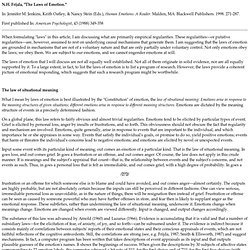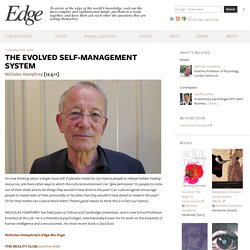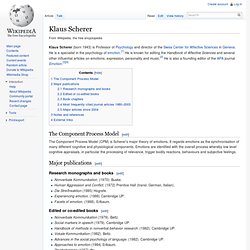

Formal Model of Action Tendencies. Steunebrink OOC model. Frijda - "The Laws of Emotion" N.H.

Frijda, "The Laws of Emotion. " In: Jennifer M. Jenkins, Keith Oatley, & Nancy Stein (Eds.), Human Emotions: A Reader. Malden, MA: Blackwell Publishers. 1998. 271-287. First published In: American Psychologist, 43 (1988) 349-358 When formulating "laws" in this article, I am discussing what are primarily empirical regularities. The laws of emotion that I will discuss are not all equally well established. The law of situational meaning What I mean by laws of emotion is best illustrated by the "Constitution" of emotion, the law of sitnational meaning: Emotions arise in response to the meaning structures of given situations; different emotions arise in response to different meaning structures. On a global plane, this law refers to fairly obvious and almost trivial regularities. Input some event with its particular kind of meaning; out comes an emotion of a particular kind. The substance of this law was advanced by Arnold (1960) and Lazarus (1966).
Emotions The law of concern. The Feeling of Action Tendencies: On the Emotional Regulation of Goal-Directed Behavior. Grief as an Emotion and as a Disease: A Social-Constructionist Perspective - Averill - 2010 - Journal of Social Issues. The Evolved Self-Management System. I realized it must be the result of a trick that has been played by human culture.

The trick isto persuade sick people that they have a "license" to get better, because they'rein the hands of supposed specialists who know what's best for them and can offer practical help and reinforcements. And the reason this works is that it reassures people—subconsciously —that the costs of self-cure will be affordable and that it's safe to let down their guard. So health has improved because of a cultural subterfuge. It's been a pretty remarkable development. I'm now thinking about a larger issue still. Go back 10 or 20,000 years ago. And they still are. Models of emottion. Klaus Scherer. The Component Process Model[edit] The Component Process Model (CPM) is Scherer's major theory of emotions.

It regards emotions as the synchronisation of many different cognitive and physiological components. Emotions are identified with the overall process whereby low level cognitive appraisals, in particular the processing of relevance, trigger bodily reactions, behaviours and subjective feelings. Swiss Center for Affective Sciences. On this page we propose research materials and tools that we are willing to share, free of charge, with qualified emotion researchers, irrespective of their discipline, for use in non-commercial research projects.

We have developed, validated and published a number of instruments to test emotion recognition ability in different modalities. Many of these instruments are shared with qualified researchers. More information can be found on our special site for Emotional Competence (EC), under Research Tools, on this page. We have also developed a research corpus with many major emotions enacted by professional actors, using affect induction procedures – the Geneva Multimodal Emotion Portrayals (GEMEP), recorded on high quality video. Parts of this corpus are also shared with qualified researchers and are widely used in the community. 1.
GAQ English versionGAQ Version FrançaiseGAQ Deutsche Version 2. Scherer / What Are Emotions and How Can They Be Measured. Scherer / Theories and Models of Emotion: A Swamp (?)